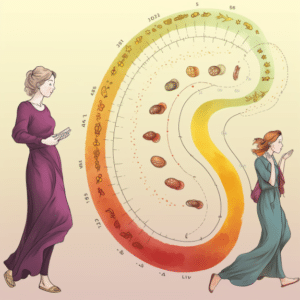
Navigating Pregnancy: Understanding the Three Vital Stages

Pregnancy Stages Understanding: Comprehending the stages of pregnancy is imperative for preggers and their significant others. This knowledge assists them in navigating the physical and emotional alterations that occur during this momentous time. It enables them to make informed decisions regarding their healthcare, ready themselves for delivery, and safeguard both mommy and baby’s well-being.
first trimester
Pregnancy involves three main stages: the first trimester, second trimester, and third trimester. Each stage brings its own unique developments and challenges. In the first trimester, the body endures substantial hormonal changes to back the growing fetus. Women might experience symptoms such as morning sickness, fatigue, and frequent urination during this time.
second trimester
As the pregnancy progresses into the second trimester, the Pregnancy Stages Understanding expectant mother may start to feel more energetic. This phase is often referred to as the “honeymoon stage” as many women find relief from earlier pregnancy discomforts. During this period, the baby’s organs keep developing quickly, and the pregnant woman may start feeling joyful movements as her baby kicks and stretches inside her tummy.
third trimester
In the third trimester, the expectation amplifies as the due date draws close. The infant continues to grow speedily, piling on weight and preparing for life outside the womb. The mother could experience physical discomforts such as backaches, swollen feet, and difficulty sleeping due to her increasing belly size. For pregnant women, prioritizing self-care during this stage is essential. This includes eating healthy, doing safe exercises prescribed by their healthcare provider, attending prenatal visits regularly, and preparing for childbirth.
Don’t miss out on the chance to improve your health and the health of your unborn child by missing out on these crucial periods of pregnancy. Parents-to-be can better ensure the health of their unborn child by preparing for each stage of pregnancy. The best way to deal with any concerns or issues that may occur is to follow the advice of healthcare specialists. Pregnancy is a precious time, so enjoy the ride and don’t waste it. The first step toward making pregnancy a positive experience for everyone involved is learning about the different phases of pregnancy.
Overview of the three main stages of pregnancy:
To understand the three main stages of pregnancy, delve into the journey of a mother-to-be. In the first trimester, witness the changes in the body and the development of the fetus. Moving into the second trimester, explore the continued growth of the fetus and the changes experienced by the mother. Lastly, the third trimester reveals the final stage of pregnancy and the anticipation of the baby’s arrival.
First Trimester: Discussing the changes that occur in the mother’s body and the development of the fetus.
The first trimester of pregnancy is significant. Significant changes occur in the mother’s body and in the fetus. Mom may experience physical and emotional changes during this time.
Morning sickness is common. It can happen at any time. Nausea and vomiting are symptoms due to hormonal changes. Mom’s breasts may get tender and swollen as they prepare for milk.
Incredible developments happen within the fetus. By week five, the heart starts beating. By week eight, major organs form. The fetus grows quickly. Facial features become more defined and limbs start to develop.
It is vital for expectant mothers to take care of themselves. Eat balanced meals that provide nutrients for mom and baby. Eating small meals often can reduce nausea. Avoid certain foods and caffeine to protect the fetus.
Regular prenatal check-ups with a healthcare provider are important. These visits monitor fetal development and address issues early. Mom should not smoke, drink alcohol, or be exposed to harmful substances. This protects her health and the unborn baby.
Sub-Heading: Physical and emotional changes during the first trimester.
The first trimester of pregnancy is a time of big changes. From the moment of conception, the body starts changing for the growth of a new life. Hormones can cause nausea, fatigue, and mood swings.
The embryo Pregnancy Stages Understanding implants in the uterus and develops fast. The expectant mother may have tender breasts, more peeing, and more vaginal discharge. These changes are normal and show the body is preparing for the baby.
Emotionally, many women feel excited and anxious. Worries about the baby’s health or life after childbirth are common. It helps to talk to loved ones or join prenatal classes.
Take care of yourself during this trimester. Eat balanced, nutrient-rich food. Avoid alcohol, tobacco, and caffeine–they can harm the baby’s development.
Second Trimester: Exploring the continued growth and development of the fetus and the changes the mother experiences.
The fetus undergoes rapid growth and development during the second trimester. By week 20, all organs are Pregnancy Stages Understanding formed. The mother may start feeling movements from the baby and her belly visibly expands. Common discomforts such as backaches and heartburn may arise.
Lanugo, a fine hair that helps regulate temperature, covers the baby’s skin. Vernix caseosa, a white substance that protects against amniotic fluid exposure, also develops. At 24 weeks, if born prematurely, medical assistance can give the baby a chance of survival.
The Miracle Baby story is remarkable. In 1987, Faye Adams gave birth 22 weeks into her pregnancy in New York City. James Elgin Gill weighed less than one pound, yet survived. His story led to changes in neonatal care practices worldwide.
It is essential that expectant mothers receive regular prenatal check-ups and take necessary precautions. This helps ensure a healthy pregnancy journey.
Sub-Heading: Nutritional needs and exercise during the second trimester.
During the second trimester of pregnancy, nutrition and exercise must be a priority.
Get the necessary nutrients for a healthy baby with a balanced diet that includes lean meats, whole grains, fruits, and veggies.
Low-impact exercises such as swimming, walking, and prenatal yoga can help. But, always check with your healthcare provider first.
Stay hydrated too! Drink 8-10 glasses of water per day.
Track your daily routine and nutrition with a journal or app.
Lastly, remember to always consult with your healthcare provider for personalized advice.
Third Trimester: Providing information on the final stage of pregnancy and the anticipation of the arrival of the baby.
The third trimester of pregnancy marks the last stage. The expectant mother experiences physical and emotional changes. The baby grows rapidly and she may feel uncomfortable. Sleep can be difficult, so it’s important to find comfy positions and do relaxation techniques. Eating healthy, staying hydrated, and exercising are key. The baby starts to have sleep-wake patterns. Parents can bond by talking or playing music near their belly.
A friend recently experienced nesting: an instinct where mothers-to-be want to ready their home for their newborn. She felt an intense urge to organize. She rearranged furniture and cleaned every spot. It was amusing and heartwarming to witness.
Sub-Heading: Preparing for labor and delivery and managing discomfort in the third trimester.
Third trimester discomfort and labor prep are vital during pregnancy. As the due date nears, take steps to make labor smoother and ease any discomforts.
- Stay active: Low-impact physical activities such as walking and swimming can help prepare your body for childbirth and provide relief.
- Practice relaxation: Deep breathing and prenatal yoga can help relax your mind and body.
- Create a birth plan: Talk to your doctor about your wishes for labor and delivery.
- Build a support system: Connect with experienced moms and attend childbirth classes for guidance.
Plus, understand Braxton Pregnancy Stages Understanding Hicks contractions (practice contractions) and how to create a comfortable sleep environment. To manage discomforts, try pelvic floor exercises, proper posture, heat packs, and a balanced diet with hydration. Following these suggestions can make for a positive birth experience. Remember, every pregnancy is unique and rely on your healthcare provider throughout.

Conclusion: Summarizing the key points and emphasizing the importance of seeking professional medical guidance throughout pregnancy.
Throughout pregnancy, seeking professional medical advice is essential. Healthcare providers can monitor the mother and baby’s health and detect potential complications. They can also help make decisions about nutrition, exercise, and medication.
By trusting healthcare professionals’ expertise, expectant mothers can get timely interventions to minimize risks. Pregnancy Stages Understanding, address concerns, give emotional support, and offer advice based on individual circumstances.
Regular check-ups and screenings are important. They can help detect any issues early. Healthcare providers can also suggest a balanced diet, safe exercise routines, and monitor blood pressure and fetal growth.
Timely interventions and professional guidance can ensure a healthy outcome for both mother and baby.
Frequently Asked Questions
1. What are the stages of pregnancy?
During pregnancy, there are three main stages:
- First Trimester: This stage lasts from conception to week 12 and is a crucial period for fetal development.
- Second Trimester: Starting from week 13, this stage is often considered the most comfortable for pregnant women. The baby continues to grow rapidly.
- Third Trimester: From week 28 until birth, the baby undergoes significant development. The mother may experience discomfort as the baby grows larger.
2. What are the signs and symptoms at each stage of pregnancy?
Signs and symptoms can vary, but some common ones in each stage include:
- First Trimester: Fatigue, nausea, breast tenderness, frequent urination, and mood swings.
- Second Trimester: Relief from morning sickness, a growing baby bump, increased energy, and feeling the baby’s movements.
- Third Trimester: Shortness of breath, backaches, frequent urination, swelling, and Braxton Hicks contractions.
3. What are the milestones in fetal development during pregnancy?
Fetal development milestones include:
- Week 4: Formation of the neural tube.
- Week 8: All major organs and body systems are present.
- Week 12: Rapid brain development, fingernails, and unique fingerprints.
- Week 20: The baby starts to hear sounds and has a fully formed digestive system.
- Week 28: Eyes can open and close, and the baby can respond to light and sound.
- Week 38-40: Final preparations for birth, such as the baby settling into a head-down position.
4. Are there any pregnancy-related risks during each stage?
While pregnancy is generally a healthy and natural process, there may be some risks associated with each stage. Common risks can include:
- First Trimester: Miscarriage, ectopic pregnancy, and birth defects.
- Second Trimester: Gestational diabetes, preeclampsia, and preterm labor.
- Anemia, hypertension, and placenta previa all manifest during the third trimester.
5. What can be done to ensure a healthy pregnancy at each stage?
The health of the mother and unborn child depends on several factors, including prenatal care, a nutritious diet, regular exercise, adequate rest, the use of prenatal vitamins, and the avoidance of dangerous substances like tobacco and alcohol.
6. When should I contact a healthcare professional during each stage?
It is important to reach out to a healthcare professional if you experience any abnormal or concerning symptoms, such as severe pain, heavy bleeding, sudden swelling, decreased fetal movement, or signs of infection, during any stage of pregnancy.